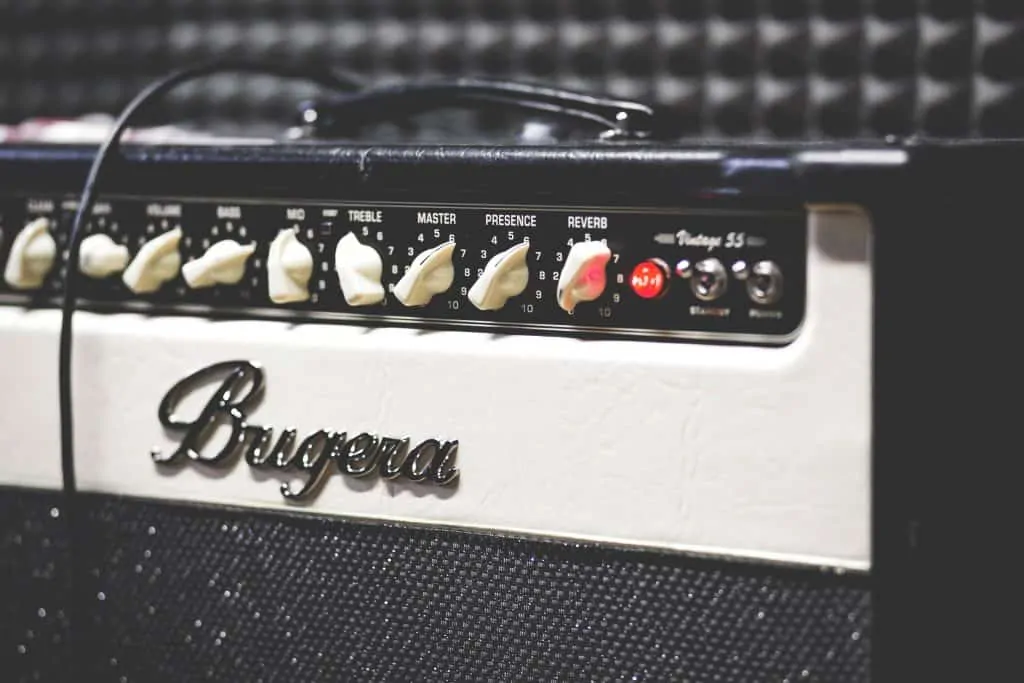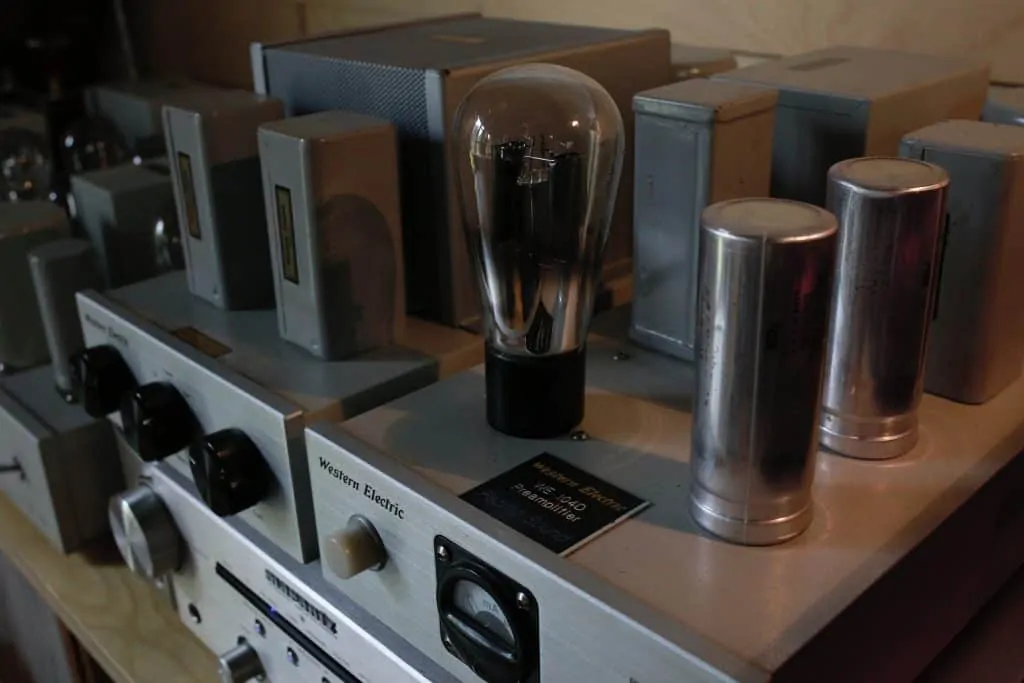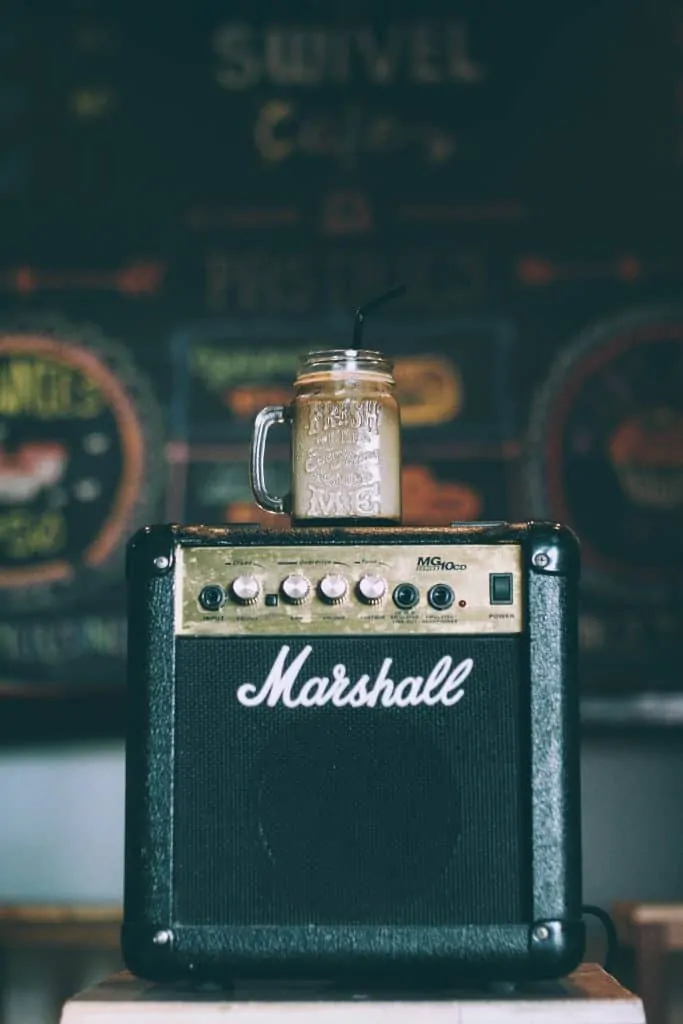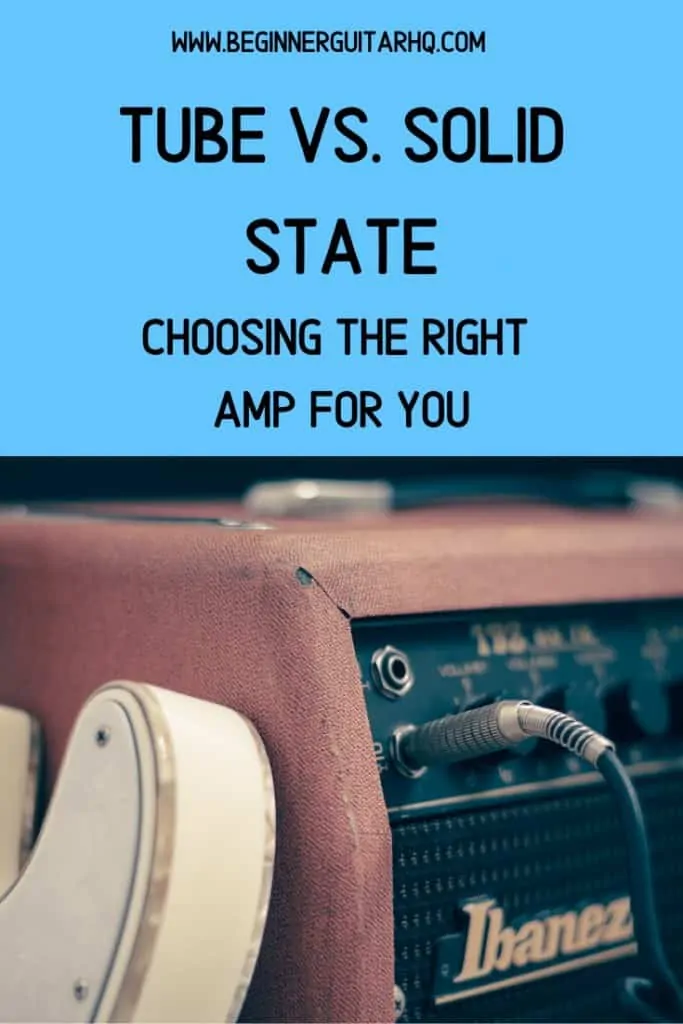One question that plagues many guitar players of all levels is what type of amp to buy. As you start your journey of tone you’ll hear the words tube (or valve) and solid state used to describe amps, but what do these terms really mean. Let’s break down the types of amplifiers that fit into each category and talk about the pros and cons of each.
This guide will help you make an informed choice on what type of amp you will be looking for. It will also answer any questions that you may have about the process and how to tell the types apart.
When choosing an amp, don’t let the numbers fool you. Wattage ratings on tube and solid state amps don’t directly link up. Solid state amps are often rated far higher due to headroom. Tube amps overdrive at a lower volume but analogue clipping is a soft clipping which is pleasant on the ear.
Solid state amps are transistor clipping which is harsh. As a result, solid state amps are rated higher to prevent clipping. A 100w solid state amp isn’t louder than a 100w tube amp. In fact, a 20w tube amp could do the same job as a 100w solid state amp but it will naturally overdrive.
Solid state amps run below their rating to ensure that they never overdrive in this way. Tube amps always run up to their rating.
Tube Amps
What are Tube Amps?
Tube amps, otherwise known as Valve amps, are a range of amplifier that use vacuum tubes to amplify the signal your guitar sends into the amplifier and push that to the speakers. Tubes have historically been used in many audio and communication setups such as tank radios in the war or radio stations around the world.
Tube amps come in all shapes and sizes, but many players prefer a tube amp with a vintage style image. Many classic records and guitar tones are recorded with tube amps. This Bugera tube amp looks classy and retro while delivering a fantastic tone.
In an amplifier circuit, a tube takes the input signal from the guitar and translates it into what we hear coming back out of the speaker. Tubes are totally analogue and as such as subject to a range of operating conditions. They will function differently depending on how they are treated.
If you turn up a tube amp, the tubes will naturally saturate and turn into overdrive. This is also true if you hit the front end of the amp with a boost pedal or you play harder. Tubes have a very wide dynamic range and are very open sounding to how the player plays through the amp.
Nuanced movements such as turning down the guitars volume knob or picking softer will result in the tubes producing a cleaner signal, and more volume and a harder attack with result in a more aggressive sound with a hint of overdrive.
Tube amps are made by most of the big amp brands and many of your favourite players, both old and new, are probably playing through tube amps. Everyone from Jimmy Page to James Hetfield is playing a tube amp of some description.
Types of Tubes
As you look into the world of tube amps, you will notice there are a range of different options when it comes to amps and the tubes that they have installed. Many players will tell you they have a preferred type of tube as each style has its own tonal characteristics.
The tubes in a guitar amp are split into two categories. Preamp tubes and power amp tubes. Preamp tubes have a very specific job, they effectively control the tonal sweep over the EQ and the gain levels as well as the FX Loop and Reverb if the amp has them.
The power amp tubes drive the whole amp. The power amp tubes give power to the amp and they have an effect on the overall voice of the amp. This is why Marshall amp sound different to Fender amps.
Power Amp Tube Types
- EL34 – Used by early Marshall and Hiwatt amps from the 1950s and early 1960s and known for its dirtier and gnarlier sound with an aggressive edge.
- 6L6 – The go to tube for cleaner amps. 6L6 tubes create the sound of American amps such as Fender. They are readily available in the States and their low distortion ceiling means the amps can be driven louder with less risk of overdriving. They have less mid than the EL style tubes used in British amps which gives American amps their more scooped tone.
- 6550 – The 6550 is a higher powered variation of a 6L6. Tonally it’s cleaner with a low distortion level with a slightly grittier midrange. Slash was a big user of this type of tube because he loved the way it made his lead lines sound fluid.
- KT88 – The KT88 is usually found in high powered amps. It’s a boosted 6550 with a huge clean headroom and a very hi-fi sound. It was originally used in a lot of home stereo systems for maximum clarity.
- EL84 – The EL84 is a midrange heavy tube designed to drive an amp circuit. Often found in lower wattage amps, the EL84 is perfect for obtaining natural overdrive with the amps volume.
- 6V6 – Fender opted for 6V6 tubes in their Deluxe Reverb and Princeton amps for its sparkly top end and fat bottom end associated with those amps. The tubes retain their clean headroom right up to the amps maximum range when they start to bark and roar in soaring overdrive.
Preamp Tube Types
- 12AX7 – The 12AX7 is the most commonly used preamp tube. You’ll find this in most amp brands as it has a gain output of 100 meaning it’s perfect for driving the power section harder. As a rule, the higher the gain output of a preamp tube, the harder it drives the amp.
- 12AT7 – A common mod with many tube amps to clean them up it to replace the 12AX7 with similar tube with lower gain output. The 12AT7 has a gain output of 60 meaning it will drive the overall amp less. The result will be a slight drop in overall volume but a cleaner tone across the board.
- 12AU7 – The 12AU7 only has a gain rating of 20 meaning that as a preamp tube, it is not ideal as it will drop a lot of volume out of the amp, however this tube often gets found in the reverb circuits of amplifiers of the phase inverter section due to its low distortion and high headroom.
This is not a comprehensive list of all available tube types, but these are the most common power and preamp tubes that you will come across on your guitar amplifier buying journey. It’s not uncommon for players to swap tubes when tweaking their tone. Preamp tubes are easier to swap than power amp tubes. Power amp tube swaps often involve needing to re-bias the amplifier and should be carried out by a professional.
Amplifier tubes come in all shapes and sizes and are split into power amp tubes (that drive the power of the am) and preamp tubes (that control the overall sound of the amp). Tubes are made from glass and become very hot when in use. Tube amps carry a lot of voltage to heat the tubes and can be dangerous to modify by an untrained person.
5 Affordable Gig Ready Tube Amps
Fender Pro Junior IV Tube Amp
The Pro Junior IV from Fender is a single channel amp with a single 10” speaker perfect for anyone wanting to make their first jump into the world of valve amps. These amps may be tiny but they sure pack a punch.
Guitar legend Jeff Beck recently used one on stage at Madison Square Gardens so they can deliver in the bedroom and on the big stage.
Perfect for low volume stages where the backline is mic’d up and a fantastic platform for anyone who uses pedals to get their tone. The control panel is simply, one volume and one tone with the volume knob designed to act as a linear breakup, the harder you push it, the harder it breaks up.
Bugera V22HD Tube Amp
The Bugera V22HD is a 22watt, vintage voiced tube head that is perfect for those cool, laid back rock riffs and those attitude filled licks. It looks retro and it’s got all that 60s and 70s mojo you want it to have.
Driven by 2 EL84 valves, this amp puts out enough power to fill most stages with relative ease. Two inputs offer the user a bright and a normal option similar to the vintage Marshall Plexi amps, though there is no option to jump the two channels together here to replicate those classic Marshall tones, this amp certainly gets you in that ballpark.
The trio of 12AX7s in the pre amp mean this amp has enough gain in the trunk to satisfy even the hungriest gain fiend but where it really comes to life is when you push it just past the point of bluesy breakup.
The built in reverb means this amp could be a one stop shop for all your retro guitar tones.
Blackstar HT20RH Tube Amp
Blackstar are no strangers to the guitar world. You’ll see their logo adorning stacks of amps behind artists of all levels across the world. For an up and coming gigging music, the HD20RH is a small package with a lot of tube tone.
This 20w head has 2 channels and is driven by a pair of EL84 tubes, the HT20RH is bursting with British midrange tones and is ready to rock. The dual channels allow the user to switch between clean and dirty and each channel also has two distinct voices.
The clean channel has an American and British voice, these voices affect the mid-range response. The American voice is more scooped and the British voice has a more prominent mid-range. The overdrive channel also has a voice switch allowing you to choose between a classic or a high gain voice.
This amp covers everything you could need in one small package.
Vox AC10C1 Tube Amp
Vox are a staple in the classic rock world with Queen’s Brian May being a big time advocate of their flagship amp, the AC30. The AC10C1 is a 10w, EL84 loaded combo ready to rock the stage. You’re probably thinking 10w isn’t quite enough to gig, but valve amps are inherently louder watt for watt than their solid state counterparts.
This little rock box can be linked to an external speaker which will help you move more air on bigger stage, but throw a mic in front of the 10” Celestion speaker and you’ll be transported straight to Bohemian Rhapsody.
Marshall DSL20H Tube Amp
For years, the Marshall DSL100 and the DSL50 were mainstays in the affordable amp market. They were full sized Marshall heads, fully tube and ready to rock that Marshall sound on a budget. In recent years Marshall has introduced a new player, the DSL20H. This 20w head is a twin channel, EL34 loaded rock machine.
Each channel has a dedicated gain and volume so you can switch between two different gain levels or a clean and dirty sound with the included foot switch. It even has an emulated output for plugging straight into the PA system at gigs, removing the need to mic the cabinet up.
This tiny box is full of nearly 60 years of Marshall tone and innovation. You can get all your classic Marshall tones and way more with one small amp.
Solid State Amps
What are Solid State Amps?
Solid state amplifiers draw their sound from a series of transistors, and not vacuum tubes. Overtime tubes will burn out and wear out but the semiconductors used in the creation of Solid State amps will not. This is where the name solid state comes from.
Due to these amps running on transistor technology, solid state amps are cheaper to manufacture and weigh a lot less than tube amps due to the reduced amount of components inside.
The biggest tonal difference between solid state amps and tube amps is the overdrive circuits. Tube amps will have a very soft clipping with a rounded overdrive. If pushed to breakup, a solid state amp will sound harsh and digital in it’s clipping. Many players that run solid state amps will use a dedicated overdrive pedal to emulate the soft clipping drive of a tube amp.
One major benefit of a solid state amp is that they can essentially be a blank canvas. If you have a great selection of pedals and you just want a loud, clean amp to work with, a solid state amp will give you everything you need and the solid state amp won’t bust the bank.
5 Affordable Gig Ready Solid State Amps
Marshall MG30GFX Solid State Amp
Marshall may be best known for their industry standard tube amps but they also produce some fantastic solid state amps. The MG30GFX is an example of a great solid state amp that is loud enough to keep up with a band.
It’s quite a small unit but it’s got a lot built in. This is one advantage of the technology in solid state amps, it’s easier to provide more features without adding extra expense. This amp has 4 main voices, clean, crunch, OD1 and OD2 as well as a plethora of effects such as chorus, phaser, flanger, delay and reverb.
Solid state amps are often considered to be just practise amps, much like this 10w Marshall amp. Don’t let the solid state tag fool you. Solid state amps can be just as useful for musicians performing and rehearsing at loud volumes.
Fender Champion 40 Solid State Amp
Imagine being able to get that classic Fender look without the classic Fender price tag. Let’s take a look at the Champion 40. This is a loud amp. 40watts of clean, snappy Fender tone in a price point that will work for any player of any level. The Champion 40 is cheap enough to be your first proper amp, but it’s good enough to be a professional gigging amp.
You’ve got a 12” speaker pushing out all those classic Fender tones across two channels. The amp has built in reverb, delay, chorus and other effects meaning you can dial in any tone you can imagine and you can adjust the voicings on the amp and distortion channel to allow you to emulate a range of other amplifiers.
What more does a gigging guitarist need? That’s before you’ve even plugged in any of your own pedals.
Blackstar IDCORE100 Solid State Amp
Blackstar made sure to deliver all the goods with this amp. It’s a 2 10” speaker loaded, 100w amp with all the bells and whistles you could need. It has 6 voices to choose from, clean warm, clean bright, crunch, super crunch, OD1 and OD2 so between any combination of those 6 voices you should be able to get this amp to replicate any rig you can imagine.
It also has what Blackstar call their super wide effects, the twin speakers enhance the stereo field and make the amp sound huge. You’ve got your built in reverb to hand along with chorus, delay and more. All the effects are USB editable with Blackstar’s Insider software and you can customise which effects are stored in the amp.
For all those jangly moments, it even has a 12-string simulator. For solo jamming, it even has a built in looper so you can record a riff and jam over the top to your heart’s content.
Boss Katana 100 Solid State Amp
This is a newer entry into the world of solid state amps, the Katana by pedal giant Boss. This amp is a single 12” Celestion designed speaker with 100w of power. You can also switch it down to a bedroom friendly 0.5w for those late night practises without bothering the neighbours.
The Katana is jam packed with effects from Boss’ award winning pedal lines. 58 to be exact. Including Flanger, Delay, Phaser, Compressor and more. If Boss have it as a pedal, it’s probably in there! You can assign eight presets to the amp meaning you can have a range of different pedals assigned to each preset. You have so many tonal options here especially if you want a one stop shop for gigging.
The amp also has 5 switchable voices, clean, crunch, lead, brown (From their high end WAZA amps) and an acoustic preamp setting. Between the 5 voices, the bucketloads of effects and the sheer volume of this amp, you’d be hard pressed to find a reason to dislike what Boss are offering.
Orange Micro Terror Head and Cab Solid State Amp
British fuzzy, gritty overdrive doesn’t get much better than Orange. The amp company that once seen, is never forgotten. The Micro Terror is their tiny, 20w head with a matching cabinet. The cabinet is bright orange, as you’d expect and comes with a single 8” speaker. On its own, this might not move much air, but this amp sounds do good if you throw a mic in front of the cab, it can handle any stage.
The head isn’t strictly solid state, it’s a hybrid. It has a solid state power amp and a tube driven preamp with a 12AX7 tube handling the gainstage. This means, you get solid state portability and price with an overdrive channel that sounds like an expensive, loud, roaring tube amp.
The Micro Terror is simple. It has a volume, tone and gain control. When the basic tone of the amp is that good, what else do you need? This amp would be a welcome addition to any guitarists arsenal.
Which Is Better?
This is one of the most asked questions in the amp buying world. Should I get a tube amp or a solid state amp? Which of these is better?
The real answer here is neither. Both have their pros and cons. Let’s refresh on a few of those:
Tube Amps
Pros
- Warm, analogue sound
- Classic tones
- Responsive to dynamics and pedals
- Easy to repair – if a tube dies, it can be replaced in seconds
- Loud – perfect for gigging. Even a smaller tube amp can overpower even the loudest drummer.
Cons
- High power consumption – lots of energy and heat generated to get desired tone
- More expensive to build
- Repairs cost more
- Need regularly servicing
- Valves need to be replaced every 1 – 3 years based on usage
Solid State Amps
Pros
- Lower cost
- Easy to get low wattage amps for home use
- Low power usage and no excess heat created
- Lighter for transporting
- Sound the same every time
Cons
- Due to their overdrive being transistor based, they aren’t as warm sounding as a tube amp.
- The natural overdrive of a solid state amp will introduce some harsh clipping elements.
- Hard to repair yourself due to the PCB, often with small surface mount components
- Less dynamic and responsive than a tube amp
Both tube amps and solid state amps have qualities that make them worthwhile and they also have downsides that make you second guess. The real answer is, there is no right answer. If you play at home you don’t need a 100w tube Marshall head with a bunch of 4×12 speaker cabinets. Similarly, if you play in an arena rock band, a 10 watt solid state amp just isn’t going to cut it.
Base your amp choice on your tone preferences, environmental needs and your budget. Always buy the best amp you can afford but more importantly, get out there and test a few out. You might surprise yourself with the quality of the tube amps vs. solid state amps out there.




